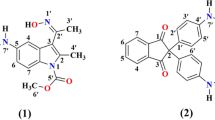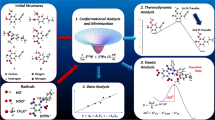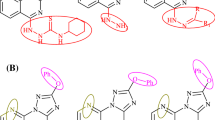Abstract
A systematic computational mechanistic and kinetics investigation has been performed on the antioxidant activity of phenyl carbamate, namely 3-morpholinopropyl phenyl carbamate (3-MPPC), against HO• and HOO• radicals. The standard density functional theory (DFT) method (M062X) is used for electronic structure calculation, and conventional transition state theory and Marcus theory are used for H-transfer and electron transfer kinetics, respectively. Four types of possible reaction mechanisms, such as hydrogen atom transfer (HAT), radical adduct formation (RAF), single electron transfer followed by proton transfer (SETPT), and sequential proton loss electron transfer (SPLET) have been considered here for investigation. 3-MPPC showed excellent HO• radical scavenging activity in the gas phase (koverall = 1.58 × 1011 M−1 s−1), water (koverall = 3.0 × 109 M−1 s−1) and pentyl ethanoate solvents (koverall = 3.8 × 109 M−1 s−1). In the case of HOO• radical scavenging activity, endothermic reactions with quite high activation energy are observed irrespective of the type of mechanisms. It was found that HAT is the most possible mechanism as it contributes approximately 97% and 93% to the overall rate (koverall) in the gas phase and the lipid medium, respectively. The RAF mechanism has a minor contribution to the scavenging of HO• radical in all the studied environments. In contrast, the SET mechanism is favorable in aqueous solution. The detailed theoretical studies will be helpful for better understanding the antioxidant activities of carbamate compounds and for further designing new potential antioxidants.




Similar content being viewed by others
Data availability
All the data are available in the supporting information.
References
Valko M, Leibfritz D, Moncol J, Cronin MTD, Mazur M, Telser J (2007) Free radicals and antioxidants in normal physiological functions and human disease. Int J Biochem Cell Biol 39:44–84
Valko M, Rhodes CJ, Moncol J, Izakovic M, Mazur M (2006) Free radicals, metals and antioxidants in oxidative stress-induced cancer. Chem Biol Interact 160:1–40
Mokini Z, Marcovecchio ML, Chiarelli F (2010) Molecular pathology of oxidative stress in diabetic angiopathy: Role of mitochondrial and cellular pathways. Diabetes Res Clin Pract 87:313–321
Ames BN, Shigenaga MK, Hagen TM (1993) Oxidants, antioxidants, and the degenerative diseases of aging. Proc Natl Acad Sci U S A 90:7915–7922
Singh U, Jialal I (2006) Oxidative stress and atherosclerosis. Pathophysiology 13:129–142
Jabeen H, Saleemi S, Razzaq H, Yaqub A, Shakoor S, Qureshi R (2018) Investigating the scavenging of reactive oxygen species by antioxidants via theoretical and experimental methods. J Photochem Photobiol B Biol 180:268–275
Yadav A, Kumari R, Yadav A, Mishra JP, Srivatva S, Prabha S (2016) Antioxidants and its functions in human body-A Review. Res Environ Life Sci 9:1328–1331
Pisoschi AM, Pop A (2015) The role of antioxidants in the chemistry of oxidative stress: A review. Eur J Med Chem 97:55–74
Kuş C, Altanlar N (2003) Synthesis of some new benzimidazole carbamate derivatives for evaluation of antifungal activity. Turkish J Chem 27:35–39
Ferriz JM, Vavrova K, Kunc F, Imramovsky A, Stolarikova J, Vavrikova E, Vinsova J (2010) Salicylanilide carbamates: Antitubercular agents active against multidrug-resistant Mycobacterium tuberculosis strains. Bioorg Med Chem 18:1054–1061
Rogers SA, Lindsey EA, Whitehead DC, Mullikin T, Melander C (2011) Synthesis and biological evaluation of 2-aminoimidazole/carbamate hybrid anti-biofilm and anti-microbial agents. Bioorg Med Chem Lett 21:1257–1260
Solyev PN, Shipitsin AV, Karpenko IL, Nosik DN, Kalnina LB, Kochetkov SN, Kukhanova MK, Jasko MV (2012) Synthesis and Anti-HIV Properties of New Carbamate Prodrugs of AZT. Chem Biol Drug Des 80:947–952
Janganati V, Penthala NR, Madadi NR, Chen Z, Crooks PA (2014) Anti-cancer activity of carbamate derivatives of melampomagnolide B. Bioorganic Med Chem Lett 24:3499–3502
Shreder KR, Lin ECK, Wu J, Cajica J, Amantea CM, Hu Y, Okerberg E, Brown HE, Pham LM, Chung DM, Fraser AS, McGee E, Rosenblum JS, Kozarich JW (2012) Synthesis and structure–activity relationship of (1-halo-2-naphthyl) carbamate-based inhibitors of KIAA1363 (NCEH1/AADACL1). Bioorg Med Chem Lett 22:5748–5751
Yanovsky I, Finkin-Groner E, Zaikin A, Lerman L, Shalom H, Zeeli S, Weill T, Ginsburg I, Nudelman A, Weinstock M (2012) Carbamate Derivatives of Indolines as Cholinesterase Inhibitors and Antioxidants for the Treatment of Alzheimer’s Disease. J Med Chem 55:10700–10715
Kurt BZ, Gazioglu I, Kandas NO, Sonmez F (2018) Synthesis, Anticholinesterase, Antioxidant, and Anti-Aflatoxigenic Activity of Novel Coumarin Carbamate Derivatives. ChemistrySelect 3:3978–3983
Ghosh AK, Brindisi M (2015) Organic Carbamates in Drug Design and Medicinal Chemistry. J Med Chem 58:2895–2940
Kolyada MN, Osipova VP, Polovinkina MA, Telekova LT, Osipova AD, Velikorodov AV, Berberova NT, Pimenov YT (2022) Evaluation of antioxidant properties of new functionally substituted aryl carbamates. AIP Conf Proc 2390:020035
Bordwell FG, Cheng JP (1991) Substituent Effects on the Stabilities of Phenoxyl Radicals and the Acidities of Phenoxyl Radical Cations. J Am Chem Soc 113:1736–1743
Bordwell FG, Zhang XM, Satish AV, Cheng JP (1994) Assessment of the Importance of Changes in Ground-State Energies on the Bond Dissociation Enthalpies of the O-H Bonds in Phenols and the S-H Bonds in Thiophenols. J Am Chem Soc 116:6605–6610
Klein E, Lukeš V (2007) DFT/B3LYP study of the substituent effect on the reaction enthalpies of the individual steps of sequential proton loss electron transfer mechanism of phenols antioxidant action: Correlation with phenolic C{single bond}O bond length. J Mol Struct THEOCHEM 805:153–160
Vagánek A, Rimarčík J, Ilčin M, Škorňa P, Lukeš KE (2013) Homolytic N-H bond cleavage in anilines: Energetics and substituent effect. Comput Theor Chem 1014:60–67
Galano A, Alvarez-Idaboy JR (2013) A computational methodology for accurate predictions of rate constants in solution: Application to the assessment of primary antioxidant activity. J Comput Chem 34:2430–2445
Galano A, Raúl Alvarez-Idaboy J (2019) Computational strategies for predicting free radical scavengers’ protection against oxidative stress: Where are we and what might follow? Int J Quantum Chem 119:e25665
Zheng YZ, Fu ZM, Guo R, Chen DF, Zhang YC (2021) The important role of benzylic CH bond in the antioxidant behaviours of the xanthones. J Food Compos Anal 103:104082
Ngoc TD, Ha MVT, Le TN, Nguyen TVA, Mechler A, Hoa NT, Vo QV (2021) Antioxidant Activity of Natural Samwirin A: Theoretical and Experimental Insights. ACS Omega 6:27546–27551
Hoa NT, Hang DTN, Hieu DP, Truong HV, HoangLP MA, Vo QV (2021) The hydroperoxyl radical scavenging activity of sulfuretin: Insights from theory. R Soc Open Sci 8:1–8
Frisch MJ, Trucks GW, Schlegel HB, Scuseria GE, Robb MA, Cheeseman JR, Scalmani G, Barone V, Petersson GA, Nakatsuji H, Li X, Caricato M, Marenich AV, Bloino J, Janesko BG, Gomperts R, Mennucci B, Hratchian HP, Ortiz JV, Izmaylov AF, Sonnenberg JL, Williams-Young D, Ding F, Lipparini F, Egidi F, Goings J, Peng B, Petrone A, Henderson T, Ranasinghe D, Zakrzewski VG, Gao J, Rega N, Zheng G, Liang W, Hada M, Ehara M, Toyota K, Fukuda R, Hasegawa J, Ishida M, Nakajima T, Honda Y,O. Kitao O, Nakai H, Vreven T, Throssell K, Montgomery Jr. JA, Peralta JE, Ogliaro F, Bearpark MJ, Heyd JJ, Brothers EN, Kudin KN, Staroverov VN, Keith TA, Kobayashi R, Normand J, Raghavachari K, Rendell AP, Burant JC, Iyengar SS, Tomasi J, Cossi M, Millam JM, Klene M, Adamo C, Cammi R, Ochterski JW, Martin RL, Morokuma K, Farkas O, Foresman JB, Fox DJ (2016) GAUSSIAN 16 (Revision B.01) Inc., Wallingford CT
Zhao Y, Truhlar DG (2008) The M06 suite of density functionals for main group thermochemistry, thermochemical kinetics, noncovalent interactions, excited states, and transition elements: Two new functionals and systematic testing of four M06-class functionals and 12 other function. Theor Chem Acc 120:215–241
Rassolov VA, Ratner MA, Pople JA, Redfern PC, Curtis LA (2001) 6–31G* basis set for third-row atoms. J Comput Chem 22:976–984
Frisch MJ, Pople JA, Binkley JS (1984) Self-consistent molecular orbital methods 25. Supplementary functions for Gaussian basis sets. J Chem Phys 80:3265–3269
Hehre WJ, Ditchfield K, Pople JA (1972) Self-consistent molecular orbital methods. XII. Further extensions of gaussian-type basis sets for use in molecular orbital studies of organic molecules. J Chem Phys 56:2257–2261
Mandal D, Sahu C, Bagchi S, Das AK (2013) Kinetics and mechanism of the tropospheric oxidation of vinyl acetate initiated by OH radical: A theoretical study. J Phys Chem A 117:3739–3750
Galano A, Alvarez-Idaboy JR (2014) Kinetics of radical-molecule reactions in aqueous solution: A benchmark study of the performance of density functional methods. J Comput Chem 35:2019–2026
Zhao Y, Truhlar DG (2008) How well can new-generation density functionals describe the energetics of bond-dissociation reactions producing radicals? J Phys Chem A 112:1095–1099
Kaur C, Mandal D (2023) The scavenging mechanism of aminopyrines towards hydroxyl radical : A computational mechanistic and kinetics investigation. Comput Theor Chem 1219:113973
Marenich AV, Cramer CJ, Truhlar DG (2009) Universal solvation model based on solute electron density and on a continuum model of the solvent defined by the bulk dielectric constant and atomic surface tensions. J Phys Chem B 113:6378–6396
Galano A (2017) Free Radicals Induced Oxidative Stress at a Molecular Level: The Current Status, Challenges and Perspectives of Computational Chemistry Based Protocols. J Mex Chem Soc 59:231–262
Dao DQ, Phan TTT, Nguyen TLA, Trinh PTH, Tran TTV, Lee JS, Shin HJ, Choi BK (2020) Insight into Antioxidant and Photoprotective Properties of Natural Compounds from Marine Fungus. J Chem Inf Model 60:1329–1351
Jacobsen RL, Johnson RD, Irikura KK, Kacker RN (2013) Anharmonic vibrational frequency calculations are not worthwhile for small basis sets. J Chem Theory Comput 9:951–954
Gonzalez C, Bernhard Schlegel H (1989) An improved algorithm for reaction path following. J Chem Phys 90:2154–2161
Gonzalez C, Schlegel HB (1991) Improved algorithms for reaction path following: Higher-order implicit algorithms. J Chem Phys 95:5853–5860
Evans MG, Polanyi M (1935) Some applications of the transition state method to the calculation of reaction velocities, especially in solution. Trans Faraday Soc 31:875–894
Eyring H (1935) The activated complex in chemical reactions. J Chem Phys 3:63–71
Dzib E, Cabellos JL, Ortíz-Chi F, Pan S, Galano A, Merino G (2019) Eyringpy: A program for computing rate constants in the gas phase and in solution. Int J Quantum Chem 119:e25686
Eckart BC (1930) The penetration of a potential barrier by electrons. Phys Rev 35:1303–1309
Klippenstein SJ, Pande VS, Truhlar DG (2014) Chemical kinetics and mechanisms of complex systems: A perspective on recent theoretical advances. J Am Chem Soc 136:528–546
Vandeputte AG, Sabbe MK, Reyniers MF, Speybroeck VV, Waroquier M, Marin GB (2007) Theoretical study of the thermodynamics and kinetics of hydrogen abstractions from hydrocarbons. J Phys Chem A 111:11771–11786
Zhang F, Dibble TS (2011) Impact of tunneling on hydrogen-migration of the n-propylperoxy radical. Phys Chem Chem Phys 13:17969–17977
Maity DK, Bell RL, Truong TN (2000) Mechanism and quantum mechanical tunneling effects on inner hydrogen atom transfer in free base porphyrin: A direct ab initio dynamics study. J Am Chem Soc 122:897–906
Marcus RA (1964) Chemical and Electrochemical Electron-Transfer Theory. Annu Rev Phys Chem 15:155–196
Marcus RA (1993) Electron Transfer Reactions in Chemistry: Theory and Experiment. Rev.modPhys 65:599–610
Nelsen SF, Blackstock SC, Kim Y (1987) Estimation of Inner Shell Marcus Terms for Amino Nitrogen Compounds by Molecular Orbital Calculations. J Am Chem Soc 109:677–682
Collins FC, Kimball GE (1949) Diffusion-controlled reaction rates. J Colloid Sci 4:425–437
Smoluchowski MV (1917) Mathematical Theory of the Kinetics of the Coagulation of Colloidal Solutions. Z Phys Chem 92:129–168
Truhlar DG (1985) Nearly Encounter-Controlled Reactions : The Equivalence of the Steady-State and Diffusional Viewpoints. J Chem Educ 62:104–106
Stokes GG (1903) Mathematical and physical papers, vol 3. Cambridge University Press, Cambridge, p 55
Einstein A (1905) On the Motion of Small Particles Suspended in Liquids at Rest Required by the Molecular-Kinetic Theory of Heat. Ann Phys 17:549–560
Boulebd H, Mechler A, Hoa NT, Vo QV (2020) Thermodynamic and kinetic studies of the antiradical activity of 5-hydroxymethylfurfural: Computational insights. New J Chem 44:9863–9869
Okuno Y (1997) Theoretical investigation of the Mechanism of the Bayer-Villiger reaction in Non polar Solvents. ChemEur J 3:212–218
Shang Y, Zhou H, Li X, Zhou J, Chen K (2019) Theoretical studies on the antioxidant activity of viniferifuran. New J Chem 43:15736–15742
Wang G, Xue Y, An L, Zheng Y, Dou Y, Zhang L, Liu Y (2015) Theoretical study on the structural and antioxidant properties of some recently synthesised 2,4,5-trimethoxy chalcones. Food Chem 171:89–97
Zheng YZ, Deng G, Liang Q, Chen DF, Guo R, Lai RC (2017) Antioxidant activity of quercetin and its glucosides from propolis: A theoretical study. Sci Rep 7:7543
Lengyel J, Rimarčík J, Vagánek A, Klein E (2013) On the radical scavenging activity of isoflavones: Thermodynamics of O-H bond cleavage. Phys Chem Chem Phys 15:10895–10903
Pérez-González A, Galano A (2012) On the •oH and •oOH scavenging activity of 3-methyl-1-pyridin-2-yl-5-pyrazolone: Comparisons with its parent compound, edaravone. Int J Quantum Chem 112:3441–3448
Hieu LT, Bay MV, Hoa NT, Mechlar A, Vo QV (2022) The radical scavenging activity of glycozolidol in physiological environments: a quantum chemical study. RSC Adv 12:32693–32699
Galano A, Pérez-González A, Castañeda-Arriaga R, Muñoz-Rugeles L, Mendoza-Sarmiento G, Romero-Silva A, Ibarra-Escutia A, Rebollar-Zepeda AM, León-Carmona JR, Hernández-Olivares MA, Alvarez-Idaboy JR (2016) Empirically Fitted Parameters for Calculating pKa Values with Small Deviations from Experiments Using a Simple Computational Strategy. J Chem Inf Model 56:1714–1724
Trung NQ, Thanh NTT, Hoa NT, Mechlar A, Vo QV (2023) Feruloylmonotropeins: promising natural antioxidants in Paederia scandens. RSC Adv 13:6153–6159
Vo QV, Tam NM, Van BM, Mechler A (2020) The radical scavenging activity of natural ramalin: A mechanistic and kinetic study. Chem Phys Lett 739:137004
Kaur C, Mandal D (2024) Insights into the HO· and HOO· radical scavenging activity of aryl carbamate derivative: a computational mechanistic and kinetic investigation. Theor Chem Acc 143:48
León-Carmona JR, Galano A (2011) Is caffeine a good scavenger of oxygenated free radicals? J Phys Chem B 115:4538–4546
Acknowledgements
D. Mandal is very much grateful to the Thapar Institute of Engineering and Technology for necessary resources. C. Kaur is thankful to TIET for providing fellowship.
Funding
This work was supported by Department of Science and Technology, Government of India, grant number: DST/INSPIRE/04/2016/001948.
Author information
Authors and Affiliations
Contributions
Conceptualization, Writing-original draft preparation, review and editing: [C.K. and D.M.]; Resources: [D.M.].
Corresponding author
Ethics declarations
Ethical approval
Not applicable.
Competing interests
The authors declare no competing interests.
Additional information
Publisher's Note
Springer Nature remains neutral with regard to jurisdictional claims in published maps and institutional affiliations.
Highlights.
• This paper addresses a DFT investigation to characterize the HO• radical scavenging mechanism of 3-morpholinopropyl phenyl carbamate.
• Hydrogen atom transfer (HAT) is found to be the most preferable mechanism compared to single-electron transfer, followed by proton transfer (SET-PT) and sequential proton loss electron transfer (SPLET).
Supplementary Information
Below is the link to the electronic supplementary material.
Rights and permissions
Springer Nature or its licensor (e.g. a society or other partner) holds exclusive rights to this article under a publishing agreement with the author(s) or other rightsholder(s); author self-archiving of the accepted manuscript version of this article is solely governed by the terms of such publishing agreement and applicable law.
About this article
Cite this article
Kaur, C., Manda, D. Radical scavenging mechanism of aryl carbamate: a computational case study using 3-morpholinopropyl phenyl carbamate. Struct Chem (2024). https://doi.org/10.1007/s11224-024-02333-1
Received:
Accepted:
Published:
DOI: https://doi.org/10.1007/s11224-024-02333-1




